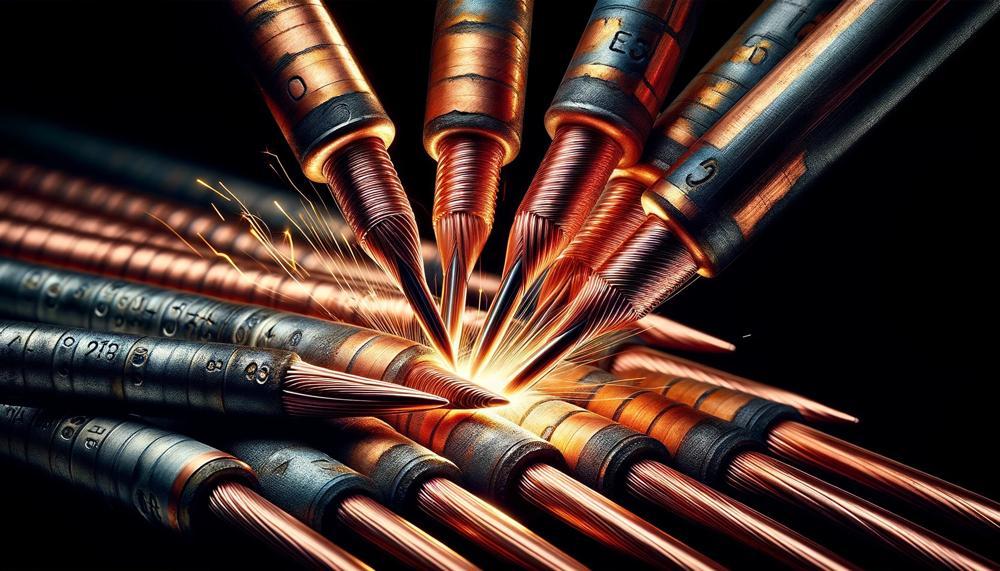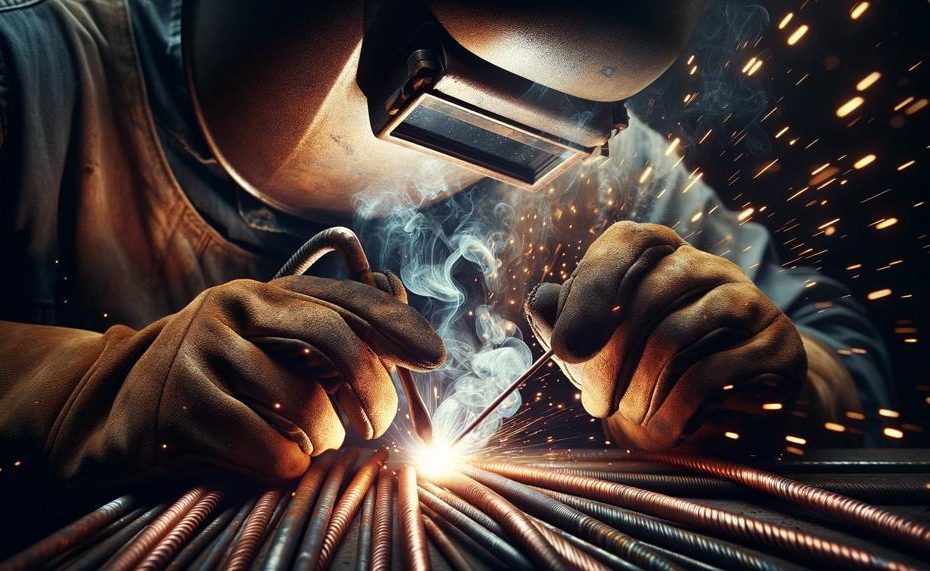In the world of metal fabrication, welding stands out as a cornerstone technique, bringing together pieces with a permanence that bolts and screws can only dream of. At the heart of this transformative process are welding electrodes, those unassuming rods that play a pivotal role in fusing metal. But there’s more to these electrodes than meets the eye, particularly when it comes to their mysterious coating.
So, why are welding electrodes coated?
The purposes of welding electrode coatings are many and include:
- Defending the metal: The coating shields the metal from environmental factors like moisture, which might weaken and fracture the rod.
- Keeping the arc stable: The coating facilitates simpler weld process control.
- Enhancing the joint: The coating enhances the chemical composition, mechanical characteristics, and cleanliness of the weld.
- Supplying a gaseous environment that is protective: The coating shields the molten weld metal while consuming the ambient oxygen.
- laying slag over heated metal to provide protection: Slag protects heated metal by covering it.
- Eliminating impurities and oxides from molten metal: The flux helps remove oxides and other impurities from the melted metals by providing flux.
- Reducing weld metal spatter: Less welding metal spatter results from the coating burning off more slowly than the core.
- Serving as a reducing agent: The layer prevents nitrogen, hydrogen, and oxygen from entering the molten metal.
- Delaying the weld’s pace of cooling: The weld cools more slowly due to the slag layer.
So, let’s ignite our torches, don our helmets, and embark on this enlightening journey together.
Contents
- 1 Electrode Classification
- 2 Covered Electrodes
- 3 Solid Electrode Wires
- 4 Shielded Metal Arc Welding Electrodes
- 5 Basic Electrodes (Low Hydrogen Electrode)
- 6 Cellulosic Electrodes
- 7 E6013 Electrodes
- 8 Stick Welding Electrodes
- 9 High Deposition Welding
- 10 Stainless Steel Electrodes
- 11 Non-Consumable Electrodes
- 12 Conclusion
Electrode Classification
Electrode coatings are pivotal in the welding process, significantly influencing the stability of the arc, the protection against oxidation, and the overall quality of the weld.
Below is a table summarizing the different types of electrode coatings and their impact on the welding process:
| Type of Coating | Main Components | Impact on Welding Process |
| Basic | Calcium carbonate, Calcium fluoride | Yields a stable, concentrated arc with minimal spatter. Excellent for thick materials, ensuring high-quality welds with deep penetration. |
| Rutile | Titanium dioxide, Potassium silicate | Produces a soft arc with low spatter, suitable for thin materials and overhead or vertical positions. Enhances mechanical properties and resistance to cracking. |
| Cellulose | Cellulose fiber | Generates a deep penetrating arc with high deposition rates, ideal for fast welding on thick materials. However, not recommended for confined spaces due to high gas production. |
| Iron Powder | Iron powder | Increase deposition rates, allowing for faster welding. Suitable for filling joints and building up welds. |
| Zirconium | Zirconium oxides | Used for welding stainless steel, providing improved arc stability and reduced spatter. |
| Rare Earth Oxides | Cerium, Lanthanum oxides | Enhances arc stability and reduces spatter. Ideal for precision welding where clean, high-quality welds are paramount. |
Each type of coating brings its unique benefits to the table. Basic electrodes are champions for heavy-duty work requiring deep penetration and minimal spatter. Rutile electrodes shine in scenarios demanding flexibility and ease, such as thin materials or awkward welding positions, thanks to their softer arc and forgiving nature.
Cellulose electrodes are the go-to for speed demons, perfect when time is of the essence yet quality can’t be compromised.
Covered Electrodes
Welding electrodes need to be coated for several pivotal reasons, ensuring they deliver top-notch performance during the welding process, which isn’t just about joining metals; it’s an art requiring precision, control, and the right equipment.
| Protection Against Oxidation and Gases | The coating acts as a knight in shining armour for the electrode, shielding it from the villainous oxygen and nitrogen in the air. Without this shield, our hero faces immediate deterioration, leading to welds that are as weak as a poorly told joke. |
| Arc Stability | Imagine trying to paint a masterpiece with a brush that keeps changing size; that’s welding without a stable arc. The coating ensures the current flows just right, making sure your welding arc isn’t dancing around like it’s at a disco. |
| Slag Control | Slag might sound like a character from a fantasy novel, but in welding, it’s less magical. It’s a byproduct that can ruin your weld if not controlled. The coating acts like a bouncer, keeping slag in check and ensuring your weld is as clean as a whistle. |
| Enhanced Weld Properties | Different strokes for different folks; not all metals are the same, and neither are their welding needs. Coatings can be mixed with special ingredients to suit specific metals or desired weld characteristics, making sure your weld doesn’t just hold but holds with style. |
Solid Electrode Wires
The purpose of coating on solid electrode wires is twofold: it serves as a safeguard against the harsh welding environment and manipulates the weld pool’s characteristics, which in turn, significantly influences the welding process.
| Aspect | Purpose of Coating | Impact on Welding Process |
|---|---|---|
| Protection | Shields the wire from oxidation and contamination. | Ensures clean, debris-free electrodes for superior performance. |
| Weld Pool Control | Dictates arc stability and penetration, shaping the weld pool. | Affects weld appearance and strength; essential for welding precision. |
| Welding Speed and Efficiency | Determines burn-off rate during welding. | Thicker coatings slow down welding; thinner coatings speed it up. |
| Arc Stability | Influences steadiness of the welding arc. | A stable arc ensures clean, smooth welds with minimal defects. |
To put it simply, the coating on solid electrode wires is a game-changer in the welding world. It’s like the secret sauce that keeps the electrode wire in tiptop shape while wrestling with high temperatures and potentially corrosive conditions. Imagine trying to achieve a perfect weld but your wire’s been compromised by rust or dirt – not happening, right? That’s where this protective layer steps in, ensuring that your wire remains as pristine as possible.
Moreover, this isn’t just about keeping things clean. The coating’s magic extends to controlling how your weld takes shape. Depending on its composition, it can make your weld pool deep and narrow or wide and shallow – talk about having control at your fingertips. And when it comes to speed, we all know time is money. A well-chosen coating can mean the difference between dragging along at a snail’s pace and zipping through your welding tasks.
Lastly, ever tried getting a perfect circle out of a shaky hand? Same idea with unstable arcs in welding. A good coating steadies the arc, giving you the precision needed for flawless results.
Shielded Metal Arc Welding Electrodes
The purpose of the coating on Shielded Metal Arc Welding (SMAW) electrodes is multifaceted, aimed at enhancing the welding process and ensuring the integrity and quality of the weld. This protective layer serves several critical roles during the welding operation:
- Creates a Protective Gas Shield: As the electrode is consumed during welding, its flux coating disintegrates, releasing vapors that form a protective gas shield around the weld pool. This shield guards against atmospheric contamination, preventing oxygen, nitrogen, and hydrogen from compromising the weld.
- Forms a Layer of Slag: The same disintegration process produces a layer of slag over the cooling weld pool. This slag acts as a protective barrier, slowing down the cooling rate and thereby reducing the risk of weld defects such as cracking.
- Stabilizes the Arc: The coating helps in stabilizing the electric arc during welding, making it easier for the welder to maintain control over the process and achieve a consistent and high-quality weld.
- Improves Weld Pool Characteristics: It can influence the fluidity and shape of the molten metal in the weld pool, aiding in better penetration and fusion of metal.
- Enhances Mechanical Properties: Certain coatings are designed to add beneficial elements to the weld deposit, improving its mechanical properties such as toughness and resistance to wear and corrosion.
| Function | Description | Benefit |
| Gas Shield Formation | Production of protective gases upon flux disintegration. | Protects against atmospheric contamination. |
| Slag Formation | Creation of a slag layer over cooling weld pool. | Slows cooling rate to reduce cracking risks. |
| Arc Stabilization | Facilitates consistent electric arc maintenance. | Enhances control over welding process. |
| Weld Pool Modification | Influences molten metal characteristics. | Aids in penetration and fusion. |
| Mechanical Property Improvement | Adds elements to improve weld deposit properties. | Increase toughness, wear, and corrosion resistance. |
Basic Electrodes (Low Hydrogen Electrode)
The purpose of coating welding electrodes, particularly with Basic Electrodes (Low Hydrogen Electrode), revolves around a few pivotal roles it plays during the welding process.
These roles are instrumental in not just ensuring a strong and durable weld but also in mitigating common welding challenges.
| Role of Coating | Function | Impact on Welding Process |
| Stabilising the Arc | Controls heat transfer rate and sustains arc stability. | Leads to smoother welding, reducing spatter and improving weld quality. |
| Creating Protective Gas Shield | Generates gases that shield the weld pool from atmospheric gases. | Prevents oxidation and contamination, crucial for clean and strong welds. |
| Forming Slag Layer | Produces slag which covers the hot weld bead. | Slows cooling rate, preventing cracking and porosity; enhances mechanical properties. |
| Reducing Hydrogen Content | Minimises hydrogen absorption into the weld pool. | Critical for preventing hydrogen-induced cracking, especially in high-strength steels. |
Specific to Basic Electrodes (Low Hydrogen Electrode), the emphasis is heavily placed on reducing the hydrogen content in the welding environment. These electrodes are meticulously designed to produce a minimal amount of hydrogen, which is fundamental in combating the risk of hydrogen embrittlement—a condition that can lead to catastrophic failure in welded structures if not properly managed.
The coating on these electrodes does more than just protect; it actively enhances the welding process by creating conditions conducive to high-quality, durable welds. It’s akin to having a seasoned guide through tricky terrain; it ensures you reach your destination (a perfect weld) safely and efficiently.
Cellulosic Electrodes
The purpose of the coating on cellulosic electrodes in welding is multifaceted, primarily focusing on enhancing welding performance and ensuring weld integrity.
The coating, rich in cellulose, plays a pivotal role in the process, contributing to deeper penetration and a stable arc.
| Stable Arc | Facilitates a more consistent and stable arc, reducing spatter and improving arc control for the welder. |
| Deep Penetration | The high cellulose content aids in achieving deep penetration, essential for welding thick materials or creating strong root passes. |
| Gas Shield Formation | Upon decomposition, the cellulose creates a protective gas shield around the weld pool, guarding against atmospheric contamination. |
| Slag Layer Formation | Forms a protective slag layer that covers the weld as it cools, preventing oxidation and facilitating cleaner welds. |
| Hydrogen Control | By providing a high hydrogen content in the arc atmosphere, it minimizes the risk of hydrogen-induced cracking in susceptible materials. |
In essence, the coating on cellulosic electrodes is engineered to tackle some of welding’s trickiest aspects head-on. Whether it’s battling contamination with a bespoke gas shield or taking penetration levels to new depths, this clever concoction ensures welders can lay down strong, resilient welds with fewer headaches.
E6013 Electrodes
The purpose of the coating on E6013 electrodes in welding is multifaceted, playing a pivotal role in safeguarding the weld pool, enhancing weld quality, and ensuring a stable welding process.
| Protection Against Atmospheric Contamination | The flux coating on E6013 electrodes generates a gas shield when melted. This shield acts as a barrier, preventing harmful gases like oxygen, nitrogen, and hydrogen from contaminating the weld pool. Such protection is crucial in averting welding defects such as porosity and cracks that compromise the integrity of the weld. |
| Deoxidizing Agent | Comprising minerals like iron powder and titanium dioxide, the flux coating serves as a powerful deoxidizer. It effectively cleanses the weld pool by removing impurities and contaminants. This deoxidizing action is particularly beneficial when welding over rusty or dirty surfaces, ensuring the resultant weld is both clean and robust. |
| Stabilization of Electrical Arc | The chemistry of the coating, including elements like potassium silicate, is designed to maintain a consistent arc length and temperature during welding. By doing so, it ensures a steady welding process, crucial for achieving an even and smooth weld bead. Fluctuations in the arc can lead to uneven penetration and weak joints; thus, this feature of the E6013 electrode’s coating is indispensable for quality welding. |

So, the coating on E6013 electrodes isn’t just an accessory; it’s a core component that enhances welding performance through atmospheric protection, purification of the weld pool, and stabilizing the electrical arc. These electrodes stand out due to their rutile-based flux coating, which strikes a perfect balance between ease of use and producing high-quality welds.
Stick Welding Electrodes
The purpose of the coating on welding electrodes is multifaceted, serving not only as a protective barrier but also significantly enhancing the welding process and the quality of the welds produced.
| Protection against contaminants | Prevents dirt, moisture, and oil from degrading the electrode’s performance. | Ensures electrode durability and consistent performance. |
| Arc stability and ease of use | Contains flux that stabilizes the arc and produces shielding gases to protect molten metal. | Results in cleaner, stronger welds with fewer defects. |
| Improvement of mechanical properties | Flux elements act as deoxidizers and alloying agents, enhancing weld strength. | Aids in achieving desired metallurgical properties in the weld. |
| Control over welding process | Helps manage heat input to prevent distortion and cracking. | Enables better control over cooling rates and weld properties. |
The coating does a bang-up job beyond mere protection. It’s a game-changer, stabilizing the arc for a smoother ride through the welding journey, kicking contaminants to the curb, beefing up those welds, and giving you the reins to steer clear of welding woes.
Choosing the right coated electrode is like picking the right tool for a job—it makes all the difference.
High Deposition Welding
It’s a go-to method for projects needing rapid, voluminous welds—think piping, pressure vessels, and structural frameworks. This process shines when it comes to mending damaged parts too, layering thick metal atop surfaces to breathe new life into them.
When it comes to the relationship between high deposition welding and the coating on welding electrodes, the connection is crucial. The flux coating on these electrodes is more than just a feature; it’s the backbone of the welding process. It ensures the arc remains stable, guards the molten metal against pesky atmospheric nasties, and generates a protective slag to shield the weld from oxidation.
| Feature | Role in High Deposition Welding | Benefit |
| Stabilizes the Arc | Keeps the welding arc steady even at high speeds. | Ensures consistent quality of welds. |
| Protects from Contamination | Shields molten metal from air, preventing defects. | Enhances weld integrity and strength. |
| Controls Heat Input | Regulates temperature during rapid welding. | Minimizes distortion and warping of the workpiece. |
| Facilitates Slag Removal | Creates an easily removable slag, crucial for thick deposits. | Saves time in post-weld clean-up and finishing. |
For high deposition welding, not just any flux will do. The coating must withstand intense heat and maintain its poise amidst swift welding actions. It’s all about creating a slag that’s easy to chip away after laying down those chunky filler layers—a feat that standard flux might baulk at.
Stainless Steel Electrodes
Stainless steel electrodes are coated for welding to ensure the integrity and quality of the weld. The coating serves several key purposes, crucial for achieving optimal results in welding projects.
| Protection Against Oxidation | The coating shields the electrode and the molten weld pool from atmospheric oxygen, preventing oxidation. This is vital because oxidation can weaken the weld, making it brittle and prone to cracking. |
| Stabilization of the Arc | Coatings help to stabilize the welding arc. This stability is crucial for creating a smooth, uniform weld bead, reducing spatter, and enhancing overall weld appearance and quality. |
| Slag Formation | The coating decomposes under the heat of welding to form slag, which floats to the surface of the molten metal. This slag layer protects the cooling weld from contamination, assists in heat control, and improves the weld’s mechanical properties. |
| Gas Shielding | As the coating burns, it generates gases that shield the weld area from harmful atmospheric gases such as nitrogen and hydrogen. This gas shield is essential for preventing porosity and inclusion defects in the weld. |
| Improved Weld Metal Properties | Certain elements in the coating can modify the chemistry of the weld metal, improving its mechanical properties such as toughness, strength, and corrosion resistance. This is particularly important for stainless steel welds that must resist corrosive environments. |
The coating on stainless steel electrodes isn’t just a protective measure; it’s a multifunctional feature that enhances every aspect of welding—from process stability to the final properties of the welded joint. Whether you’re patching up a damaged part or crafting something brand new, understanding the role of this coating can make all the difference in your welding endeavours.
Non-Consumable Electrodes
In the world of welding, non-consumable electrodes stand out for their durability and efficiency. Coating these electrodes is not just a matter of protocol; it’s an art that ensures they perform at their best, allowing for smoother welds and superior finishes.
Here’s a dive into the materials commonly used for coating these stalwarts of the welding world and how this layer of protection influences the welding ballet.
Common Coating Materials for Non-Consumable Welding Electrodes:
| Material | Function | Impact on Welding Process |
| Graphite | Improves conductivity and arc stability | Reduces spatter, stabilizes the arc, provides a smooth finish |
| Titanium Dioxide | Increases electrical conductivity | Enhances arc stability, improves weld penetration, reduces spatter |
| Cellulose | Acts as a binding agent, prevents oxidation | Stabilizes arc, improves penetration, protects electrode |
| Sodium Silicate | Binder, creates protective layer | Prevents oxidation, stabilizes arc, enhances weld quality |
| Potassium Silicate | Binder, forms protective barrier | Improves arc stability, protects against oxidation, boosts weld appearance |
The Ripple Effect of Coatings on Welding:
Coatings on non-consumable electrodes are not just about preventing wear and tear; they’re pivotal in shaping the welding experience. For starters, these coatings shield the electrode from the harshness of oxidation, ensuring it remains steadfast in its role.
They’ve got a knack for improving arc stability too – think of them as the steadying hand guiding the electrode through its journey.
And when it comes to spatter, these coatings have got it covered, literally. By reducing spatter, they make for cleaner welds and less cleanup time.
But that’s not all. The coatings are like conductors in an orchestra, enhancing electrical conductivity and ensuring every part of the welding process plays in harmony. This leads to deeper weld penetration and stronger bonds.
Plus, with improved arc stability courtesy of these coatings, welders can enjoy a smoother ride, free from the hiccups of an unstable arc.
Conclusion
As we come to the end of our exploration of the complex world of welding electrodes and coatings, it is evident that these layers are the fundamental components that distinguish welding as both an art and a science. Like a knight’s armor, the coating on a welding electrode provides protection, stability, and improved performance against the harsh metal manufacturing environment.
These coatings make sure that welders can produce strong, long-lasting connections with elegance and accuracy, protecting against air enemies like oxygen and nitrogen and stabilizing the electric arc like taming a wild beast. They turn a regular rod into a versatile instrument that can create welds that are both visually beautiful and structurally solid. Every kind of coating, whether it be cellulose, iron powder, rutile, or basic, offers a specific set of benefits and handles various materials and welding difficulties like old pros in their industry.
Furthermore, by lowering exposure to dangerous chemicals and UV radiation, these coatings not only improve weld quality and simplicity of use but also play a critical role in improving safety and health in welding procedures. It’s evidence of how innovation keeps improving and redefining metalworking procedures.
To summarize, the foundation of each successful metal manufacturing job is a set of coated welding electrodes. They are important figures whose contributions go much beyond their outward look. Welders depend on these coated electrodes, just as expert craftsmen do with their instruments or cooks do with their ingredients, to overcome obstacles and develop their profession.





